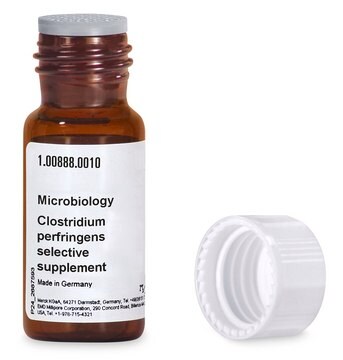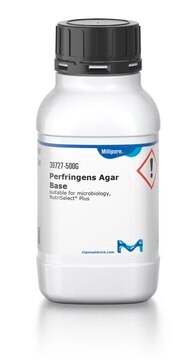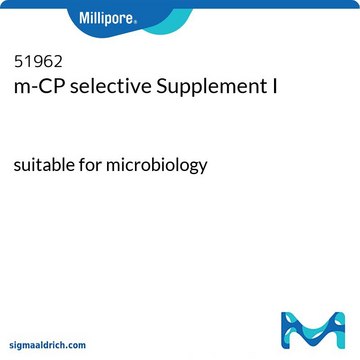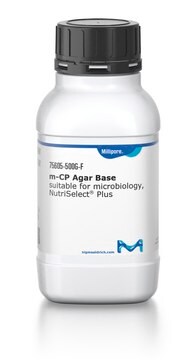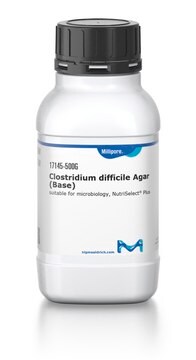Key Documents
93745
TSC Agar
suitable for microbiology, NutriSelect® Basic
Synonim(y):
Tryptose Sulfite Cycloserine Agar
About This Item
Polecane produkty
agency
according to ISO 15213:2003
according to ISO 7937:2004
Poziom jakości
sterylność
non-sterile
Postać
powder
okres trwałości
limited shelf life, expiry date on the label
skład
agar, 15 g/L
ammonium ferric citrate, 1 g/L
meat peptone (peptic), 15 g/L
sodium disulfite, 1 g/L
soya peptone, 5 g/L
yeast extract, 5 g/L
producent / nazwa handlowa
NutriSelect® Basic
metody
microbiological culture: suitable
pH końcowe
7.6±0.2 (25 °C)
Zastosowanie
agriculture
clinical testing
environmental
food and beverages
pathogen testing
water monitoring
microbiology
przydatność
selective and differential for Clostridium spp.
Zastosowanie
Uwaga dotycząca przygotowania
Dissolve 42 g in 1 litre distilled water. Sterilize by autoclaving at 121°C for 15 minutes. Cooling to approx. 50°C.
TSC Agar:
To 1 litre Base Agar add 400 mg rehydrated D-cycloserine (Cat. No. 30020) as a sterile filtered aqueous solution or 2 vials of Perfringens T.S.C. Supplement (Cat. No. P9352) and 50 ml Egg Yolk Emulsion (Cat. No. 17148). Mix well and pour into petri plates.
TSC Agar egg yolk free (also used as overlay agar):
Add 400 mg rehydrated D-cycloserine (Cat. No. 30020) or 2 vials of Perfringens T.S.C. Supplement (Cat. No. P9352) to 1 litre Base Agar and mix well.
TSC Fluorescence Agar:
Add to 1 litre Base Agar 5.5 g rehydrated TSC Agar supplement (Cat. No. 80548) as a sterile filtered aqueous solution. Mix well and pour plates.
SFP Agar (Shahidi-Ferguson Perfringens Agar):
To 1 litre Base Agar 2 vials of Perfringens S.F.P. Supplement Cat. No. P9477) and 50 ml Egg Yolk Emulsion (Cat. No. 17148) are added. Mix well and pour into sterile petri plates.
Inne uwagi
Przypis
The designations basic, plus, or prime are added to indicate the quality control level, from basic quality control to standard QC plus to prime for full regulatory compliance.
Informacje prawne
Hasło ostrzegawcze
Warning
Zwroty wskazujące rodzaj zagrożenia
Zwroty wskazujące środki ostrożności
Klasyfikacja zagrożeń
Eye Irrit. 2
Kod klasy składowania
11 - Combustible Solids
Klasa zagrożenia wodnego (WGK)
WGK 3
Temperatura zapłonu (°F)
Not applicable
Temperatura zapłonu (°C)
Not applicable
Środki ochrony indywidualnej
Eyeshields, Gloves, type N95 (US)
Wybierz jedną z najnowszych wersji:
Masz już ten produkt?
Dokumenty związane z niedawno zakupionymi produktami zostały zamieszczone w Bibliotece dokumentów.
Klienci oglądali również te produkty
Nasz zespół naukowców ma doświadczenie we wszystkich obszarach badań, w tym w naukach przyrodniczych, materiałoznawstwie, syntezie chemicznej, chromatografii, analityce i wielu innych dziedzinach.
Skontaktuj się z zespołem ds. pomocy technicznej
